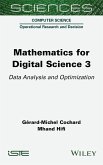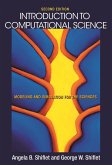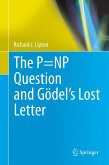- Gebundenes Buch
- Merkliste
- Auf die Merkliste
- Bewerten Bewerten
- Teilen
- Produkt teilen
- Produkterinnerung
- Produkterinnerung
Over the past century, advancements in computer science have consistently resulted from extensive mathematical work. Even today, innovations in the digital domain continue to be grounded in a strong mathematical foundation. To succeed in this profession, both today's students and tomorrow's computer engineers need a solid mathematical background. The goal of this book series is to offer a solid foundation of the knowledge essential to working in the digital sector. Across three volumes, it explores fundamental principles, digital information, data analysis, and optimization. Whether the reader…mehr
Andere Kunden interessierten sich auch für
![Mathematics for Digital Science 2 Mathematics for Digital Science 2]() Gérard-Michel CochardMathematics for Digital Science 2147,99 €
Gérard-Michel CochardMathematics for Digital Science 2147,99 €![Mathematics for Digital Science 3 Mathematics for Digital Science 3]() Gérard-Michel CochardMathematics for Digital Science 3147,99 €
Gérard-Michel CochardMathematics for Digital Science 3147,99 €![Fork Algebras in Algebra, Logic and Computer Science Fork Algebras in Algebra, Logic and Computer Science]() Marcelo Fabian FriasFork Algebras in Algebra, Logic and Computer Science78,99 €
Marcelo Fabian FriasFork Algebras in Algebra, Logic and Computer Science78,99 €![Introduction to Computational Science Introduction to Computational Science]() Angela B ShifletIntroduction to Computational Science119,99 €
Angela B ShifletIntroduction to Computational Science119,99 €![Space Strategy Space Strategy]() Jean-Luc LefebvreSpace Strategy160,99 €
Jean-Luc LefebvreSpace Strategy160,99 €![Mobile Malware Attacks and Defense Mobile Malware Attacks and Defense]() Ken DunhamMobile Malware Attacks and Defense44,99 €
Ken DunhamMobile Malware Attacks and Defense44,99 €![The P=np Question and Gödel's Lost Letter The P=np Question and Gödel's Lost Letter]() Richard J. LiptonThe P=np Question and Gödel's Lost Letter76,99 €
Richard J. LiptonThe P=np Question and Gödel's Lost Letter76,99 €-
-
-
Over the past century, advancements in computer science have consistently resulted from extensive mathematical work. Even today, innovations in the digital domain continue to be grounded in a strong mathematical foundation. To succeed in this profession, both today's students and tomorrow's computer engineers need a solid mathematical background. The goal of this book series is to offer a solid foundation of the knowledge essential to working in the digital sector. Across three volumes, it explores fundamental principles, digital information, data analysis, and optimization. Whether the reader is pursuing initial training or looking to deepen their expertise, the Mathematics for Digital Science series revisits familiar concepts, helping them refresh and expand their knowledge while also introducing equally essential, newer topics.
Produktdetails
- Produktdetails
- Verlag: Wiley
- Seitenzahl: 368
- Erscheinungstermin: 4. Februar 2025
- Englisch
- Abmessung: 234mm x 156mm x 21mm
- Gewicht: 676g
- ISBN-13: 9781789451948
- ISBN-10: 1789451949
- Artikelnr.: 72703902
- Herstellerkennzeichnung
- Libri GmbH
- Europaallee 1
- 36244 Bad Hersfeld
- gpsr@libri.de
- Verlag: Wiley
- Seitenzahl: 368
- Erscheinungstermin: 4. Februar 2025
- Englisch
- Abmessung: 234mm x 156mm x 21mm
- Gewicht: 676g
- ISBN-13: 9781789451948
- ISBN-10: 1789451949
- Artikelnr.: 72703902
- Herstellerkennzeichnung
- Libri GmbH
- Europaallee 1
- 36244 Bad Hersfeld
- gpsr@libri.de
Gérard-Michel Cochard is Professor Emeritus at Université de Picardie Jules Verne, France, where he has held various senior positions. He has also served at the French Ministry of Education and the CNAM (Conservatoire National des Arts et Métiers). His research is conducted at the Eco-PRocédés, Optimisation et Aide à la Décision (EPROAD) laboratory, France. Mhand Hifi is Professor of Computer Science at Université de Picardie Jules Verne, France, where he heads the EPROAD UR 4669 laboratory and manages the ROD team. As an expert in operations research and NP-hard problem-solving, he actively contributes to numerous international conferences and journals in the field.
Preface ix
Chapter 1. The Concept of Logic 1
1.1. Syllogisms 1
1.2. Elementary operations of propositional calculus 5
1.2.1. Negation 5
1.2.2. Conjunction 6
1.2.3. Disjunction 7
1.2.4. Conditional 8
1.2.5. Biconditional 10
1.2.6. Tautologies 10
1.3. Tools of deductive reasoning 14
1.4. Quantification 17
1.5. Prenex forms and pure forms 20
Chapter 2. Sets and Relationships 25
2.1. Generalities 25
2.2. Algebra of sets 29
2.3. Parts and partitions 30
2.4. Cartesian product 31
2.5. Binary relationships 32
2.6. Properties of relationships 35
2.7. Applications 42
Chapter 3. Counting and Combinatorial Analysis 47
3.1. Set cardinals 47
3.2. Permutations, arrangements, combinations 48
3.3. Properties of binomial coefficients 51
3.4. Stirling's formula 54
Chapter 4. Boolean Algebra and Boolean Functions 61
4.1. Special elements of an ordered set 61
4.2. Lattice 66
4.3. Boolean algebra 68
4.4. Boolean functions 72
Chapter 5. Logic Circuits 75
5.1. Canonical forms of a Boolean function 75
5.2. Reduction of a Boolean function 80
5.3. Karnaugh tables 84
5.4. Elementary logic circuits 87
5.5. A little on electronics 93
5.6. Construction of logical functions 97
5.7. A basic circuit: the binary adder 100
Chapter 6. Arithmetic 103
6.1. Reminder about integers 103
6.2. Euclidean division 104
6.3. Divisibility and prime numbers 106
6.4. GCD and LCM 112
6.5. Congruencies 116
6.6. Elliptic curves 121
6.7. Identity, theorem and Bézout algorithm 127
Chapter 7. Error Protection 131
7.1. General context 131
7.2. Linear codes 136
7.3. Polynomial codes 140
7.4. Convolutional codes 142
Chapter 8. Encryption Systems 145
8.1. Substitution and transposition 145
8.2. Substitution methods 147
8.2.1. Replacement of a symbol by a symbol 147
8.2.2. The code: replacement of a word by a word 157
8.3. Transposition methods 158
8.4. Asymmetric systems 159
8.5. DES -- secret key system 160
8.6. RSA -- public key system 165
8.7. Cryptography with elliptic curves 167
8.8. Quantum cryptography 169
8.9. Appendix: the Crow and the Fox 176
Chapter 9. Probabilities 177
9.1. Chance 177
9.2. Counting and probabilities 178
9.3. Events and probabilities 183
9.4. Statistics and probabilities 189
9.5. Compound probabilities 191
9.6. Graphs, states, transitions 195
9.7. Markov chains 199
9.7.1. Definition 199
9.7.2. Transition matrix 201
9.7.3. Evolution rules 205
9.7.4. Ergodicity 206
Chapter 10. Descriptive Statistics 213
10.1. Statistical description 213
10.1.1. A little vocabulary 213
10.1.2. Tabular presentation and frequency 215
10.1.3. Two-dimensional series 219
10.2. Graphical representations 220
10.2.1. Bar charts 220
10.2.2. Histograms 222
10.2.3. Cumulative diagrams 223
10.2.4. Polar diagrams 226
10.2.5. Pie charts 227
10.2.6. Figurative diagrams 227
10.2.7. Point clouds 228
10.3. Position parameters 229
10.3.1. Mode 229
10.3.2. Median 230
10.3.3. Averages 235
10.3.4. Comparison of position parameters 237
10.4. Dispersion parameters 238
10.4.1. Range, interquartile range, mean range 238
10.4.2. Variance and standard deviation 240
10.4.3. Coefficient of variation and concentration index 242
10.5. Linear adjustment 243
10.5.1. Principle of adjustment 243
10.5.2. Linear adjustment 248
10.6. Chronological series 254
10.6.1. Introduction 254
10.6.2. Study of the general trend 257
10.6.3. Study of seasonal variations 260
10.7. Covariance and correlation 265
10.7.1. Regression lines 265
10.7.2. Linear correlation 268
Chapter 11. Probability Laws and Simulation 273
11.1. Random variables 273
11.2. Mathematical expectation, variance and standard deviation 283
11.3. Distribution function 287
11.4. Usual probability laws 289
11.4.1. Uniform law 289
11.4.2. Binomial or Bernoulli's law 290
11.4.3. Poisson's law 293
11.4.4. Exponential law 294
11.4.5. Normal law 298
11.5. General information on simulation 305
11.5.1. Weak law of large numbers 305
11.5.2. Some simulations 308
11.5.3. Generation of random numbers 313
11.6. Generating programs 316
11.6.1. Usual laws 317
11.6.2. Any probability law 318
11.7. M/M/1 waiting system 320
11.7.1. Theoretical study 322
11.7.2. Simulation 326
11.8. Appendices 333
11.8.1. Appendix 1: Table for Poisson's law 333
11.8.2. Appendix 2: Table for normal law 334
11.8.3. Appendix 3: Buffon's needle 335
11.8.4. Appendix 4: Results for M/M/1 337
References 339
List of Authors 341
Index 343
Chapter 1. The Concept of Logic 1
1.1. Syllogisms 1
1.2. Elementary operations of propositional calculus 5
1.2.1. Negation 5
1.2.2. Conjunction 6
1.2.3. Disjunction 7
1.2.4. Conditional 8
1.2.5. Biconditional 10
1.2.6. Tautologies 10
1.3. Tools of deductive reasoning 14
1.4. Quantification 17
1.5. Prenex forms and pure forms 20
Chapter 2. Sets and Relationships 25
2.1. Generalities 25
2.2. Algebra of sets 29
2.3. Parts and partitions 30
2.4. Cartesian product 31
2.5. Binary relationships 32
2.6. Properties of relationships 35
2.7. Applications 42
Chapter 3. Counting and Combinatorial Analysis 47
3.1. Set cardinals 47
3.2. Permutations, arrangements, combinations 48
3.3. Properties of binomial coefficients 51
3.4. Stirling's formula 54
Chapter 4. Boolean Algebra and Boolean Functions 61
4.1. Special elements of an ordered set 61
4.2. Lattice 66
4.3. Boolean algebra 68
4.4. Boolean functions 72
Chapter 5. Logic Circuits 75
5.1. Canonical forms of a Boolean function 75
5.2. Reduction of a Boolean function 80
5.3. Karnaugh tables 84
5.4. Elementary logic circuits 87
5.5. A little on electronics 93
5.6. Construction of logical functions 97
5.7. A basic circuit: the binary adder 100
Chapter 6. Arithmetic 103
6.1. Reminder about integers 103
6.2. Euclidean division 104
6.3. Divisibility and prime numbers 106
6.4. GCD and LCM 112
6.5. Congruencies 116
6.6. Elliptic curves 121
6.7. Identity, theorem and Bézout algorithm 127
Chapter 7. Error Protection 131
7.1. General context 131
7.2. Linear codes 136
7.3. Polynomial codes 140
7.4. Convolutional codes 142
Chapter 8. Encryption Systems 145
8.1. Substitution and transposition 145
8.2. Substitution methods 147
8.2.1. Replacement of a symbol by a symbol 147
8.2.2. The code: replacement of a word by a word 157
8.3. Transposition methods 158
8.4. Asymmetric systems 159
8.5. DES -- secret key system 160
8.6. RSA -- public key system 165
8.7. Cryptography with elliptic curves 167
8.8. Quantum cryptography 169
8.9. Appendix: the Crow and the Fox 176
Chapter 9. Probabilities 177
9.1. Chance 177
9.2. Counting and probabilities 178
9.3. Events and probabilities 183
9.4. Statistics and probabilities 189
9.5. Compound probabilities 191
9.6. Graphs, states, transitions 195
9.7. Markov chains 199
9.7.1. Definition 199
9.7.2. Transition matrix 201
9.7.3. Evolution rules 205
9.7.4. Ergodicity 206
Chapter 10. Descriptive Statistics 213
10.1. Statistical description 213
10.1.1. A little vocabulary 213
10.1.2. Tabular presentation and frequency 215
10.1.3. Two-dimensional series 219
10.2. Graphical representations 220
10.2.1. Bar charts 220
10.2.2. Histograms 222
10.2.3. Cumulative diagrams 223
10.2.4. Polar diagrams 226
10.2.5. Pie charts 227
10.2.6. Figurative diagrams 227
10.2.7. Point clouds 228
10.3. Position parameters 229
10.3.1. Mode 229
10.3.2. Median 230
10.3.3. Averages 235
10.3.4. Comparison of position parameters 237
10.4. Dispersion parameters 238
10.4.1. Range, interquartile range, mean range 238
10.4.2. Variance and standard deviation 240
10.4.3. Coefficient of variation and concentration index 242
10.5. Linear adjustment 243
10.5.1. Principle of adjustment 243
10.5.2. Linear adjustment 248
10.6. Chronological series 254
10.6.1. Introduction 254
10.6.2. Study of the general trend 257
10.6.3. Study of seasonal variations 260
10.7. Covariance and correlation 265
10.7.1. Regression lines 265
10.7.2. Linear correlation 268
Chapter 11. Probability Laws and Simulation 273
11.1. Random variables 273
11.2. Mathematical expectation, variance and standard deviation 283
11.3. Distribution function 287
11.4. Usual probability laws 289
11.4.1. Uniform law 289
11.4.2. Binomial or Bernoulli's law 290
11.4.3. Poisson's law 293
11.4.4. Exponential law 294
11.4.5. Normal law 298
11.5. General information on simulation 305
11.5.1. Weak law of large numbers 305
11.5.2. Some simulations 308
11.5.3. Generation of random numbers 313
11.6. Generating programs 316
11.6.1. Usual laws 317
11.6.2. Any probability law 318
11.7. M/M/1 waiting system 320
11.7.1. Theoretical study 322
11.7.2. Simulation 326
11.8. Appendices 333
11.8.1. Appendix 1: Table for Poisson's law 333
11.8.2. Appendix 2: Table for normal law 334
11.8.3. Appendix 3: Buffon's needle 335
11.8.4. Appendix 4: Results for M/M/1 337
References 339
List of Authors 341
Index 343
Preface ix
Chapter 1. The Concept of Logic 1
1.1. Syllogisms 1
1.2. Elementary operations of propositional calculus 5
1.2.1. Negation 5
1.2.2. Conjunction 6
1.2.3. Disjunction 7
1.2.4. Conditional 8
1.2.5. Biconditional 10
1.2.6. Tautologies 10
1.3. Tools of deductive reasoning 14
1.4. Quantification 17
1.5. Prenex forms and pure forms 20
Chapter 2. Sets and Relationships 25
2.1. Generalities 25
2.2. Algebra of sets 29
2.3. Parts and partitions 30
2.4. Cartesian product 31
2.5. Binary relationships 32
2.6. Properties of relationships 35
2.7. Applications 42
Chapter 3. Counting and Combinatorial Analysis 47
3.1. Set cardinals 47
3.2. Permutations, arrangements, combinations 48
3.3. Properties of binomial coefficients 51
3.4. Stirling's formula 54
Chapter 4. Boolean Algebra and Boolean Functions 61
4.1. Special elements of an ordered set 61
4.2. Lattice 66
4.3. Boolean algebra 68
4.4. Boolean functions 72
Chapter 5. Logic Circuits 75
5.1. Canonical forms of a Boolean function 75
5.2. Reduction of a Boolean function 80
5.3. Karnaugh tables 84
5.4. Elementary logic circuits 87
5.5. A little on electronics 93
5.6. Construction of logical functions 97
5.7. A basic circuit: the binary adder 100
Chapter 6. Arithmetic 103
6.1. Reminder about integers 103
6.2. Euclidean division 104
6.3. Divisibility and prime numbers 106
6.4. GCD and LCM 112
6.5. Congruencies 116
6.6. Elliptic curves 121
6.7. Identity, theorem and Bézout algorithm 127
Chapter 7. Error Protection 131
7.1. General context 131
7.2. Linear codes 136
7.3. Polynomial codes 140
7.4. Convolutional codes 142
Chapter 8. Encryption Systems 145
8.1. Substitution and transposition 145
8.2. Substitution methods 147
8.2.1. Replacement of a symbol by a symbol 147
8.2.2. The code: replacement of a word by a word 157
8.3. Transposition methods 158
8.4. Asymmetric systems 159
8.5. DES -- secret key system 160
8.6. RSA -- public key system 165
8.7. Cryptography with elliptic curves 167
8.8. Quantum cryptography 169
8.9. Appendix: the Crow and the Fox 176
Chapter 9. Probabilities 177
9.1. Chance 177
9.2. Counting and probabilities 178
9.3. Events and probabilities 183
9.4. Statistics and probabilities 189
9.5. Compound probabilities 191
9.6. Graphs, states, transitions 195
9.7. Markov chains 199
9.7.1. Definition 199
9.7.2. Transition matrix 201
9.7.3. Evolution rules 205
9.7.4. Ergodicity 206
Chapter 10. Descriptive Statistics 213
10.1. Statistical description 213
10.1.1. A little vocabulary 213
10.1.2. Tabular presentation and frequency 215
10.1.3. Two-dimensional series 219
10.2. Graphical representations 220
10.2.1. Bar charts 220
10.2.2. Histograms 222
10.2.3. Cumulative diagrams 223
10.2.4. Polar diagrams 226
10.2.5. Pie charts 227
10.2.6. Figurative diagrams 227
10.2.7. Point clouds 228
10.3. Position parameters 229
10.3.1. Mode 229
10.3.2. Median 230
10.3.3. Averages 235
10.3.4. Comparison of position parameters 237
10.4. Dispersion parameters 238
10.4.1. Range, interquartile range, mean range 238
10.4.2. Variance and standard deviation 240
10.4.3. Coefficient of variation and concentration index 242
10.5. Linear adjustment 243
10.5.1. Principle of adjustment 243
10.5.2. Linear adjustment 248
10.6. Chronological series 254
10.6.1. Introduction 254
10.6.2. Study of the general trend 257
10.6.3. Study of seasonal variations 260
10.7. Covariance and correlation 265
10.7.1. Regression lines 265
10.7.2. Linear correlation 268
Chapter 11. Probability Laws and Simulation 273
11.1. Random variables 273
11.2. Mathematical expectation, variance and standard deviation 283
11.3. Distribution function 287
11.4. Usual probability laws 289
11.4.1. Uniform law 289
11.4.2. Binomial or Bernoulli's law 290
11.4.3. Poisson's law 293
11.4.4. Exponential law 294
11.4.5. Normal law 298
11.5. General information on simulation 305
11.5.1. Weak law of large numbers 305
11.5.2. Some simulations 308
11.5.3. Generation of random numbers 313
11.6. Generating programs 316
11.6.1. Usual laws 317
11.6.2. Any probability law 318
11.7. M/M/1 waiting system 320
11.7.1. Theoretical study 322
11.7.2. Simulation 326
11.8. Appendices 333
11.8.1. Appendix 1: Table for Poisson's law 333
11.8.2. Appendix 2: Table for normal law 334
11.8.3. Appendix 3: Buffon's needle 335
11.8.4. Appendix 4: Results for M/M/1 337
References 339
List of Authors 341
Index 343
Chapter 1. The Concept of Logic 1
1.1. Syllogisms 1
1.2. Elementary operations of propositional calculus 5
1.2.1. Negation 5
1.2.2. Conjunction 6
1.2.3. Disjunction 7
1.2.4. Conditional 8
1.2.5. Biconditional 10
1.2.6. Tautologies 10
1.3. Tools of deductive reasoning 14
1.4. Quantification 17
1.5. Prenex forms and pure forms 20
Chapter 2. Sets and Relationships 25
2.1. Generalities 25
2.2. Algebra of sets 29
2.3. Parts and partitions 30
2.4. Cartesian product 31
2.5. Binary relationships 32
2.6. Properties of relationships 35
2.7. Applications 42
Chapter 3. Counting and Combinatorial Analysis 47
3.1. Set cardinals 47
3.2. Permutations, arrangements, combinations 48
3.3. Properties of binomial coefficients 51
3.4. Stirling's formula 54
Chapter 4. Boolean Algebra and Boolean Functions 61
4.1. Special elements of an ordered set 61
4.2. Lattice 66
4.3. Boolean algebra 68
4.4. Boolean functions 72
Chapter 5. Logic Circuits 75
5.1. Canonical forms of a Boolean function 75
5.2. Reduction of a Boolean function 80
5.3. Karnaugh tables 84
5.4. Elementary logic circuits 87
5.5. A little on electronics 93
5.6. Construction of logical functions 97
5.7. A basic circuit: the binary adder 100
Chapter 6. Arithmetic 103
6.1. Reminder about integers 103
6.2. Euclidean division 104
6.3. Divisibility and prime numbers 106
6.4. GCD and LCM 112
6.5. Congruencies 116
6.6. Elliptic curves 121
6.7. Identity, theorem and Bézout algorithm 127
Chapter 7. Error Protection 131
7.1. General context 131
7.2. Linear codes 136
7.3. Polynomial codes 140
7.4. Convolutional codes 142
Chapter 8. Encryption Systems 145
8.1. Substitution and transposition 145
8.2. Substitution methods 147
8.2.1. Replacement of a symbol by a symbol 147
8.2.2. The code: replacement of a word by a word 157
8.3. Transposition methods 158
8.4. Asymmetric systems 159
8.5. DES -- secret key system 160
8.6. RSA -- public key system 165
8.7. Cryptography with elliptic curves 167
8.8. Quantum cryptography 169
8.9. Appendix: the Crow and the Fox 176
Chapter 9. Probabilities 177
9.1. Chance 177
9.2. Counting and probabilities 178
9.3. Events and probabilities 183
9.4. Statistics and probabilities 189
9.5. Compound probabilities 191
9.6. Graphs, states, transitions 195
9.7. Markov chains 199
9.7.1. Definition 199
9.7.2. Transition matrix 201
9.7.3. Evolution rules 205
9.7.4. Ergodicity 206
Chapter 10. Descriptive Statistics 213
10.1. Statistical description 213
10.1.1. A little vocabulary 213
10.1.2. Tabular presentation and frequency 215
10.1.3. Two-dimensional series 219
10.2. Graphical representations 220
10.2.1. Bar charts 220
10.2.2. Histograms 222
10.2.3. Cumulative diagrams 223
10.2.4. Polar diagrams 226
10.2.5. Pie charts 227
10.2.6. Figurative diagrams 227
10.2.7. Point clouds 228
10.3. Position parameters 229
10.3.1. Mode 229
10.3.2. Median 230
10.3.3. Averages 235
10.3.4. Comparison of position parameters 237
10.4. Dispersion parameters 238
10.4.1. Range, interquartile range, mean range 238
10.4.2. Variance and standard deviation 240
10.4.3. Coefficient of variation and concentration index 242
10.5. Linear adjustment 243
10.5.1. Principle of adjustment 243
10.5.2. Linear adjustment 248
10.6. Chronological series 254
10.6.1. Introduction 254
10.6.2. Study of the general trend 257
10.6.3. Study of seasonal variations 260
10.7. Covariance and correlation 265
10.7.1. Regression lines 265
10.7.2. Linear correlation 268
Chapter 11. Probability Laws and Simulation 273
11.1. Random variables 273
11.2. Mathematical expectation, variance and standard deviation 283
11.3. Distribution function 287
11.4. Usual probability laws 289
11.4.1. Uniform law 289
11.4.2. Binomial or Bernoulli's law 290
11.4.3. Poisson's law 293
11.4.4. Exponential law 294
11.4.5. Normal law 298
11.5. General information on simulation 305
11.5.1. Weak law of large numbers 305
11.5.2. Some simulations 308
11.5.3. Generation of random numbers 313
11.6. Generating programs 316
11.6.1. Usual laws 317
11.6.2. Any probability law 318
11.7. M/M/1 waiting system 320
11.7.1. Theoretical study 322
11.7.2. Simulation 326
11.8. Appendices 333
11.8.1. Appendix 1: Table for Poisson's law 333
11.8.2. Appendix 2: Table for normal law 334
11.8.3. Appendix 3: Buffon's needle 335
11.8.4. Appendix 4: Results for M/M/1 337
References 339
List of Authors 341
Index 343









